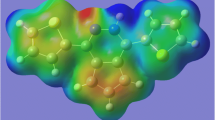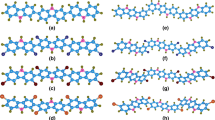Abstract
The structure–properties relationship of heterocyclic polymethines on the all-optical switching processing (AOSP) is studied by CC2 method. In particular, the excitation energies of the first and second excited states (E ge and E ge′ ) and the corresponding ratio (R ee′ = E ge′ /E ge, energy window width) are evaluated. The comparable energy gap between HOMO and HOMO − 1 (π type) and between LUMO and LUMO + 1 (π* type) is the key in keeping R ee′ large. Moreover, only a significant increase of such energy gap can result in the increase in R ee′ because the energy gap is a poor description of excitation energy. The results show that the heavy heteroatoms decrease the E ge and E ge′ as expected compared to light atoms such as carbon. For five-membered heterocyclic polymethines and their derivatives (two heteroatoms in total), the R ee′ is stable around 1.7 reflecting the nature of this system: The additional heteroatoms have little effects on the width of energy window. In the case of six-membered heterocyclic polymethines and their derivatives, the decrease in excitation energy is more effective compared to the former due to the relative large effective length of the end group, which can thus help avoiding the symmetry breaking. The effect of heteroatoms on R ee′ is clear that it helps keeping the energy window open compared to carbon atom. The heavier the heteroatom is, the higher R ee′ value will be when it is on the ortho position. Consequently, at least one heteroatom is necessary on the design of polymethines for AOSP application.









Similar content being viewed by others
References
Hales JM, Matichak J, Barlow S, Ohira S, Yesudas K, Bredas JL, Perry JW, Marder SR (2010) Design of polymethine dyes with large third-order optical nonlinearities and loss figures of merit. Science 327:1485–1488
Hales JM, Barlow S, Kim H, Mukhopadhyay S, Brédas J-L, Perry JW, Marder SR (2014) Design of organic chromophores for all-optical signal processing applications. Chem Mater 26:549–560
Mukhopadhyay S, Risko C, Marder SR, Brédas J-L (2012) Polymethine dyes for all-optical switching applications: a quantum-chemical characterization of counter-ion and aggregation effects on the third-order nonlinear optical response. Chem Sci 3:3103
Hales JM, Zheng S, Barlow S, Marder SR, Perry JW (2006) Bisdioxaborine polymethines with large third-order nonlinearities for all-optical signal processing. J Am Chem Soc 128:11362–11363
Gieseking RL, Mukhopadhyay S, Risko C, Marder SR, Bredas JL (2014) 25th anniversary article: design of polymethine dyes for all-optical switching applications—guidance from theoretical and computational studies. Adv Mater 26:68–83
Wang C, Yuan Y, Tian X, Sun J, Shao H, Sun Z (2013) A theoretical study on the structural dependences of third-order optical nonlinearities of heterocycle-substituted polymethine cyanine chromophores. Chem Phys Lett 583:185–189
Dirk CW, Cheng L-T, Kuzyk MG (1992) A simplified three-level model describing the molecular third-order nonlinear optical susceptibility. Int J Quantum Chem 43:27–36
Orr BJ, Ward JF (1971) Perturbation theory of the non-linear optical polarization of an isolated system. Mol Phys 20:513–526
Meyers F, Marder SR, Pierce BM, Bredas JL (1994) Electric field modulated nonlinear optical properties of donor-acceptor polyenes: sum-over-states investigation of the relationship between molecular polarizabilities (alpha, beta, and gamma) and bond length alternation. J Am Chem Soc 116:10703–10714
Bredas JL, Adant C, Tackx P, Persoons A, Pierce BM (1994) Third-order nonlinear optical response in organic materials: theoretical and experimental aspects. Chem Rev 94:243–278
Matichak JD, Hales JM, Barlow S, Perry JW, Marder SR (2011) Dioxaborine- and indole-terminated polymethines: effects of bridge substitution on absorption spectra and third-order polarizabilities. J Phys Chem A 115:2160–2168
Matichak JD, Hales JM, Ohira S, Barlow S, Jang SH, Jen AK, Bredas JL, Perry JW, Marder SR (2010) Using end groups to tune the linear and nonlinear optical properties of bis(dioxaborine)-terminated polymethine dyes. ChemPhysChem 11:130–138
Tolbert LM, Zhao X (1997) Beyond the cyanine limit: peierls distortion and symmetry collapse in a polymethine dye. J Am Chem Soc 119:3253–3258
Gieseking RL, Mukhopadhyay S, Risko C, Brédas J-L (2014) Impact of the nature of the excited-state transition dipole moments on the third-order nonlinear optical response of polymethine dyes for all-optical switching applications. ACS Photonics 1:261–269
Fu J, Padilha LA, Hagan DJ, Van Stryland EW, Przhonska OV, Bondar MV, Slominsky YL, Kachkovski AD (2007) Molecular structure—two-photon absorption property relations in polymethine dyes. J Opt Soc Am B 24:56
Padilha LA, Webster S, Przhonska OV, Hu H, Peceli D, Ensley TR, Bondar MV, Gerasov AO, Kovtun YP, Shandura MP, Kachkovski AD, Hagan DJ, Van Stryland EW (2010) Efficient two-photon absorbing acceptor-pi-acceptor polymethine dyes. J Phys Chem A 114:6493–6501
Le Guennic B, Jacquemin D (2015) Taking up the cyanine challenge with quantum tools. Acc Chem Res 48:530
Adamo C, Jacquemin D (2013) The calculations of excited-state properties with time-dependent density functional theory. Chem Soc Rev 42:845–856
Yesudas K (2013) Cationic cyanine dyes: impact of symmetry-breaking on optical absorption and third-order polarizabilities. Phys Chem Chem Phys 15:19465–19477
Send R, Valsson O, Filippi C (2011) Electronic excitations of simple cyanine dyes: reconciling density functional and wave function methods. J Chem Theory Comput 7:444–455
Schreiber M, Silva-Junior MR, Sauer SP, Thiel W (2008) Benchmarks for electronically excited states: CASPT2, CC2, CCSD, and CC3. J Chem Phys 128:134110
Frisch MJ, GWT HB, Schlegel HB, Scuseria GE, Robb MA, Cheeseman JR, Scalmani G, Barone V, Mennucci B, Petersson GA, Nakatsuji H, Caricato M, Li X, Hratchian HP, Izmaylov AF, Bloino J, Zheng G, Sonnenberg JL, Hada M, Ehara M, Toyota K, Fukuda R, Hasegawa J, Ishida M, Nakajima T, Honda Y, Kitao O, Nakai H, Vreven T, Montgomery JA, Peralta JE Jr, Ogliaro F, Bearpark M, Heyd JJ, Brothers E, Kudin KN, Staroverov VN, Kobayashi R, Normand J, Raghavachari K, Rendell A, Burant JC, Iyengar SS, Tomasi J, Cossi M, Rega N, Millam JM, Klene M, Knox JE, Cross JB, Bakken V, Adamo C, Jaramillo J, Gomperts R, Stratmann RE, Yazyev O, Austin AJ, Cammi R, Pomelli C, Ochterski JW, Martin RL, Morokuma K, Zakrzewski VG, Voth GA, Salvador P, Dannenberg JJ, Dapprich S, Daniels AD, Farkas Ö, Foresman JB, Ortiz JV, Cioslowski J, Fox DJ (2009) Gaussian 09. B.01 edn. Gaussian, Inc., Wallingford CT
Furche F, Ahlrichs R, Hättig C, Klopper W, Sierka M, Weigend F (2014) Turbomole. Wiley Interdiscip Rev Comput Mol Sci 4:91–100
Jacquemin D, Chibani S, Le Guennic B, Mennucci B (2014) Solvent effects on cyanine derivatives: a PCM investigation. J Phys Chem A 118:5343–5348
Bertolino CA, Ferrari AM, Barolo C, Viscardi G, Caputo G, Coluccia S (2006) Solvent effect on indocyanine dyes: a computational approach. Chem Phys 330:52–59
Lu T, Chen F (2012) Multiwfn: a multifunctional wavefunction analyzer. J Comput Chem 33:580–592
Humphrey W, Dalke A, Schulten K (1996) VMD: visual molecular dynamics. J Mol Graphics 14:33–38
Bricks JL, Kachkovskii AD, Slominskii YL, Gerasov AO, Popov SV (2015) Molecular design of near infrared polymethine dyes: a review. Dyes Pigm 121:238–255
Acknowledgments
This research was supported by the Fundamental Research Funds for the Central Universities (22A201514002), Shanghai leading academic discipline project (No. B502), Shanghai key laboratory project (No. 08DZ2230500). We thank Georgia Institute of Technology for the computer resources.
Author information
Authors and Affiliations
Corresponding authors
Electronic supplementary material
Below is the link to the electronic supplementary material.
Rights and permissions
About this article
Cite this article
Wang, C., Yuan, Y., Tian, X. et al. The effect of heteroatoms and end groups of polymethines on the all-optical switching processing application: a CC2 calculation. Struct Chem 27, 1211–1220 (2016). https://doi.org/10.1007/s11224-016-0746-5
Received:
Accepted:
Published:
Issue Date:
DOI: https://doi.org/10.1007/s11224-016-0746-5




